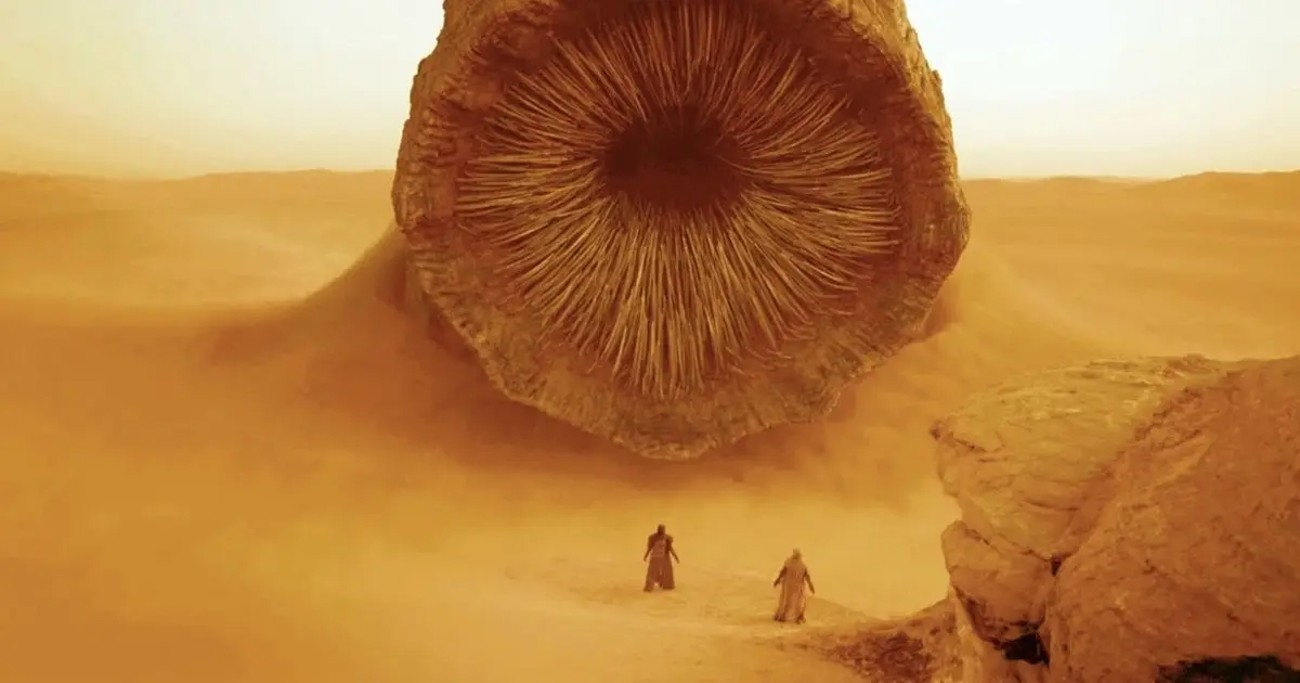
This article contains dune spoilers for across the saga.
Even the most casual Dune fan knows that, at some point, there’s a giant worm boy. Since its first printing in 1981, Frank Herbert’s fourth book in the franchise, God Emperor of Dune, has proudly displayed a human/sandworm hybrid on its cover. Dune fans know that hybrid as Leto II, the son of Paul Atreides and Chani, who melds with a sandworm and becomes an all-powerful tyrant. Leto II is also one of the most fantastic elements of the Dune franchise, a series already filled with images wonderful and bizarre. God Emperor of Dune also isn’t part of Denis Villeneuve‘s planned series of films based on the first three Herbert books.
To the faithful, the idea of introducing sandworm Leto during the events of Dune Messiah is as painful as anything endured in the Gom Jabbar. But not only will Dune 3 be potentially the only time to give viewers at least a glimpse of the God Emperor, but such a vision fits within the themes of Villeneuve’s adaptation. Let us explain.
Dawn of the Tyrant
Leto II and his twin sister Ghanima make their debut at the end of 1969’s Dune Messiah, the second book in the series. They are two of the main characters of Children of Dune (1976), where they’re targeted by several plots to gain control of House Atredies’ power. And each sibling since birth has enjoyed a seemingly supernatural prescience. Leto’s prescience shows him a way that he calls “the Golden Path,” the one way that humanity can thrive. To protect that path, Leto throws himself into a school of sandtrout, the larvae of sandworms, and physically merges with them. The conversion gives Leto extreme strength and near invulnerability, allowing him to live for millennia. But it also costs him his humanity, transforming him into a hideous creature that disgusts even his beloved sister.
When God Emperor of Dune opens 3,500 years later, Leto has grown into that more hideous creature, one marked by physical impotence as much as he is his enormous power. Dubbed “the Tyrant,” Leto has been ruthless in his control on humanity, making many enemies along the way, including ghola clones of Duncan Idaho, who continue to appear this far into the future. However, Leto justifies it all with what he calls “the Golden Path,” dismissing complaints about his behavior as just the reactions of those who don’t understand all that must be done for humanity.
Leto II represents the next stage of consequences for Paul’s actions. Throughout the first Dune and the two books that follow, Paul feels trapped by his destiny, haunted by the terrible decisions that he must make and the results of those decisions. The Tyrant Leto II is one of the more terrifying outcomes of Paul’s choices, which both is why and how Villeneuve can include the God Emperor in Dune: Part Three.
The Worm Boy Rises
The arrival of Leto and Ghanima is perhaps the most moving part of Dune Messiah. Not only does Chani die giving birth to the twins, but Paul has been blinded by a stone-burner attack launched as part of one conspiracy against him. Now he must face another. The Tleilaxu Master Scytale offers to recreate Chani as a ghola/clone in exchange for all of Paul’s holdings in CHOAM, the spacing guild which monopolizes all space travel in the Dune universe. At the same time, Paul must deal with a potentially corrupted Alia and with a ghola of Duncan Idaho, programmed as an assassin in waiting.
Yet at this moment of grief and danger, Paul believes that his vision has returned. He quickly realizes that he’s seeing through the eyes of his son Leto, who like both Alia and Ghamina, has been born with full genetic awareness. Through Leto, Paul witnesses not only his physical surroundings but also his past lineage, including his own father Leto and his grandfather beyond. This combination of danger, tenderness, and awareness of lineage captures the main themes of Dune Messiah. The book imagines Paul as a figure of incredible power, who makes decisions that kill billions in his jihad, but who is also powerless to stop his fate. It’s almost as if he’s wandering through time instead of effecting it—something that Herbert doesn’t clarify until 1984’s Heretics of Dune.
Impotence among the powerful has been a key theme in Villeneuve’s two Dune movies, as has playing with timelines. When Paul sees visions of himself in the jihad, he curses his mother Jessica and the Bene Geserit for condemning him to a life of cruelty. That same ability to see the future allows Villeneuve to show a grown Alia before her birth in Dune: Part Two.
Thanks to Villeneuve’s willingness to play with the timeline in service of underscoring his movies’ themes, the birth scene offers the perfect opportunity to include the God Emperor in full wormy form. While Paul sees his ancestors through the vision of the infant Leto II, he also thinks about the future, to the legacy that he will have. Paul has made every decision according to what he considers best for humanity and for his family. If he sees what his decisions will do to both humanity and his son, transforming the latter into an inhuman beast who subjugates the former, then Paul’s tragic downfall will be complete.
The Golden Path to the God Emperor
Honestly, it’s not very likely that God Emperor of Dune will ever be directly adapted, at least not as a project on the level of Dune and Dune: Part Two. Children of Dune also more or less closes out the story that began in Dune. Major characters such as Paul, Chani, Baron Harkonnen, and Gurney Halleck return in one form or another to provide a final statement on Paul’s journey as the Kwisatz Haderach.
Conversely, God Emperor of Dune jumps ahead thousands of years, scuttling most of the characters and reimagining elements such as the Fremen, who become museum pieces in a desert enclave on the rich and verdant Arrakis. Furthermore, Dune has connected with mass audiences, in part, because of its familiar tropes and what could be misunderstood as simple morality: Paul = good, Harkonnen = bad.
Herbert intended to complicate the simplistic morality common to science fiction and fantasy stories, and when he felt that Dune failed to achieve the intended effect, he made the complications more pronounced in the follow-ups. Dune Messiah begins with Paul having murdered billions in his intergalactic jihad, a necessary sacrifice for the good of humanity. Or so he tells himself. In Children of Dune, the Atreides and Harkonnen lines blend even further, to the point that Alia becomes possessed by Baron Harkonnen and tries to murder Leto II and Ghanima.
Essentially, the comfort and familiarity that helped mass audiences make sense of Dune goes away in the sequels. It’s a challenge Villeneuve’s Dune 3 will face regardless of whether he brings in elements from other books or just sticks to Dune Messiah.
In light of such odds, it is important that Villeneuve take advantage of the public (and studio’s) good will, as well as time-bending elements of the story, to show us Leto II as a worm person in Dune: Part Three or whatever the next film might be named. The God Emperor needs to appear, not just because it’s an amazing and hideous image that we want to see on the big screen, but because the fate of Leto II is inseparable from the tragedy of Paul Atreides that Villeneuve has traced across the first two films.
Dune: Part Two is now streaming on Max.
The post Dune 3 Needs to Include This Children of Dune Storyline appeared first on Den of Geek.







